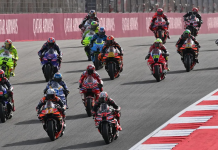Copyright 2004, Roadracing World Publishing, Inc.
FIRST PERSON/OPINION
Via e-mail:
Rubbish. Dr. Gaudino suggests that parallax could have produced a 1 second timing error in the case of the 205-mph speeder in Minnesota, but simple geometry shows that’s not likely. The worst case would be for a pilot sitting over the start of the 1/4-mile marker, then trying to time when the bike passes the end of the run. For a rural minimum fixed-wing aircraft altitude of 500 feet, the angle of view at the end of the run would be about 21 degrees. A crouched rider sitting 4 feet off the ground would cast a “shadow” that is about 10 feet long at this angle, so this is the maximum parallax distance error. 180 mph is 264 feet/second, so the bike covers 10 feet in 0.038 seconds, which is the maximum parallax timing error. Converted to an inferred speed, this would only be an error of about 1.5 mph. A much more likely explanation for the error (I don’t believe the guy was doing 205 mph either) is the pilot trying to “time” his reactions to the bike passing either or both markers.
Jeffrey Koch, Ph.D.
AFM #964
Livermore, California
FIRST PERSON/OPINION
Via e-mail:
I suspect Dr. Gaudino may be a little confused.
The mechanics of a parallax are simple: you stand somebody in front of a wall on which a scale is marked, they will appear taller or shorter depending on whether your point of view is, respectively, lower or higher than the top of their head. It’s a combination of the angle of observation and the distance from the person being measured to the wall.
In the case of a motorcycle viewed from above, it’s the height of the bike above the road. That’s about a metre (40″). So even if you viewed from an angle of 60 degrees from vertical, the error would be limited to about 1.7m.
Moreover that doesn’t matter if the same mistake is made at both beginning and end of the timed distance. In a worst case scenario, suppose the plane was flying at only 200m. Then the parallax error would be about 1m at each end of the run, for a total error of 2m. As for the curvature of the earth, which has a radius of 6400km, that will contribute an additional 0.0036 degrees of error over 400m.
Now 205mph is 91m/s, so a 2m error would lead to a timing error of 22 milliseconds, or 1/2 of one percent, or 1 mph. I’d say simple reaction time would be much greater than that.
Is it possible? The news item didn’t mention a standing start, so the question is whether a street bike can attain 205 mph (328km/h). We know that MotoGP bikes (ok, not the Proton) regularly achieve this thanks to about 240-250 hp. It’s certainly true that no standard road-legal motorcycle could manage that, but there are people out there who attach turbochargers and nitrous oxide systems to large sport bikes. Even heavily discounting their claims for bravado, 300 hp would seem possible and account for the extra aerodynamic drag of road-bike paraphenalia.
This is not to say the trooper didn’t get it wrong for any number of reasons, but parallax is not one of them and physics will not provide a defense.
Graham Byrnes BSc PhD (applied mathematics)
The University of Melbourne
Melbourne, Victoria, Australia
FIRST PERSON/OPINION
Via e-mail:
Every e-mail so far is dismissing the whole thing, making arguments against the trooper being wrong for estimating 205 mph. This is disappointing.
Everyone seems to miss the REAL point, that some idiots were out racing their bikes, riding 160+ mph on public roads. +1 second error = 5.4 seconds = 168 mph. This is ridiculous in its own right anywhere but the track. Hell, I don’t even get that fast at TWS on an R6.
So the cop’s mistake was over-estimating the speed. That doesn’t excuse these riders for being dumb.
Jesse Johnson
CMRA #21 Expert
Austin, Texas
FIRST PERSON/OPINION
Via e-mail:
I just wanted to comment on the ridiculous speeding violation reported by our local and national media.
The kid riding the so called “Honda 1000” was indeed riding a 1000cc Honda, just not the one you’d expect. He was actually riding an RC51. I have reliable sources at the scene who were passing by and spoke with the unlicensed rider (and saw his bike) just after his being pulled over while participating in the Minnesota Flood Run motorcycle ride which took place along the same route on highway 61.
Nick Junkersfeld
Motoprimo Motorsports
Minneapolis, Minnesota
FIRST PERSON/OPINION
Via e-mail:
just a quick note in addition to Dr. Gaudino’s response:
Did you guys notice that he’s not on a CBR1000RR; he’s on an RC51! (I got this information here:
http://www.kare11.com/news/news_article.aspx?storyid=69711).
To make an RC51 go over 200 mph is a HUGE accomplishment. I’m not saying it’s totally impossible, but to make any bike go over 200 is tough; but an RC51? A guy with no license taking the time to build an RC51 capable of such a feat is amazing.
I agree with the good doctor’s response; the accuracy of this speed is highly questionable.
Steve Bauman
CRA #169
St. Bonifacius, Minnesota
FIRST PERSON/OPINION
Via e-mail:
I am absolutely certain, without reservation, that the facts presented to me for this story of a 205 mph motorcycle are true.
Dan Rather
New York, New York
(Eric A. Trytko, Dearborn, Michigan)
FIRST PERSON/OPINION
Via e-mail:
I don’t want to get into a huge battle over this and waste your time and webspace. I also can’t seem to find the article again at the original web location so I can’t quote from the article to support my arguments, so that’s even more reason not to get into it.
But from the beginning, my e-mail said that the ideas I was presenting were enough to put reasonable doubt into minds of people who put any thought into this. My entire post was directed to the factors in the entire “event” that could contribute human error and thus reasonable doubt into a reasonable persons mind. Dr. Byrne seems more intent on showing how I erred in saying that Parallax could have played any part, than in showing why it doesn’t. If anything, he supports that idea. He quantifies the various amounts of error that ARE introduced, and then tries to say they are too small to be of any consequence. BUT, he doesn’t say what the error he has quantified will do to affect the way the HUMAN at the observing end responds, i.e. starting and stopping the stop watch. He also doesn’t comment on the following:
1) ANY maneuvering of the plane to be able to track that motorcycle (if they weren’t already traveling in the same direction OR perpendicular to the direction of travel so that the plane was at right angle to the section of road where the lines were painted) would possibly introduce a situation where human error could affect the timing.
2) The response also didn’t take into account any hills that may have changed the viewer’s ability to accurately judge when to time. Perspective changes as the distance and angle from which an event is viewed. It IS possible that a perspective change on a hill (up or down) could create an optical illusion where it seems the motorcycle crossed the line sooner (and yes it could change it so it seemed to cross later as well) when viewing from a distance, especially if that distance is removed in 2 directions, distance away and distance above. I don’t say this did happen because I am making no assumptions regarding this, but it COULD happen , and thus it could contribute to human error in timing. Without being there witnessing it, there is no way to say for sure one way or the other.
3) Dr. Byrne’s response graciously provides the additional error caused by curvature of the earth, which would tend to add error to the timing event. Which was my point. Timing errors.
4) The short duration of the event, makes any error approaching 1/2 a second a significant amount of error. Enough error in fact to make the measurement completely suspect. And if its suspect, then its capable of being the basis for reasonable doubt, which in turn supports my other statement…a decent lawyer could get this case tossed or reduced.
I will admit that I assumed that the timing event started when the bike accelerated and then finished when he clicked and saw 4.39 seconds. It is possible I misinterpreted the officers action. From Dr. Byrne’s response it would seem that the motorcycle had already accelerated to the terminal speed and that is when the officer started timing the event. I can’t verify, so I’m willing to concede that point.
However, Dr. Byrne doesn’t address what the apparent acceleration away from the plane at a rate of twice that of the plane does to the ability to accurately judge when to start and stop the timing event, thus he offers no comment on any possible human error introduced by any or all of these circumstances. I would ask Dr. Byrne if he’s ever tried to time a motorcycle between 2 white lines from hundreds of feet in the air and from a position that would possibly be the worst of all circumstances, above and behind the event with the bike moving away faster than the vehicle that is being used to spot it. Forget that there could be additional factors of plane movement that could alter the ability to accurately judge.
The next 2 points I think are very important as well. The American Justice system probably doesn’t work like the British Justice system…ANY reasonable doubt, can get a case reduced or overturned. I realize that Dr. Byrne is from Australia, but the legal system practiced there is basically the British legal system with very few changes. In fact they still wear the wigs in court. Our system which started as the British legal system has changed considerably from the original British system.
And in this case Physics DOES provide some reasonable doubt. Dr. Byrne seems to be confused about how the Law works here in the USA. The bike is probably in impound…so it would be easy enough for a lawyer to bring it in as an exhibit and show what its state of tune is. I agree that a 300 hp cbr1000 rr might have enough horsepower to travel at 205 mph…but that is a HUGE assumption. Since I can’t see the bike, I chose not to assume anything about its state of tune. I chose to determine if small amounts of human error could in fact create the seemingly impossible discrepancy between what was claimed and what we motorcycle riders and racers should know is a VERY difficult plateau to reach. And then determine if those timing errors reduced the speed which seems outrageous to a speed more in line with what we, as reasonable motorcycle racers and riders, know to be possible for stock and moderately tuned streetbikes.
Occams Razor suggests, that all things being equal the simplest answer is usually correct, or stated another way, the less assumptions made, the greater the probability of an answer being correct.
Dr. Byrne says that a 300 hp motorcycle might be able to attain that speed. And he is correct, it MIGHT. But he ASSUMES that the rider had the time, the money, and the ability to build or have built for him, a 300 hp streetbike, when he makes that statement. My argument makes no such assumption. My argument is based on parallax, which is a known and naturally occurring physical phenomena (as is perspective change), and human error which could be introduced due to viewing inaccuracies. The human error factor is my assumption, because in order to reduce the 205 mph to a more believable 180 mph or 168 mph , a half second to 1 second error is introduced which represents either 10 or 20 % timing error, respectively. This is important. The basis of my post is about the timing event. An interval that short, needs only a minor error to completely blow it.
Anyway, I won’t be upset at all if you decide not to waste any more space on this and don’t print this. I really don’t want to get into a physics and mathematics debate, since I’m not a physicist or mathematician. My only purpose for responding to Dr. Byrne’s post at all was to let you know I’m not a complete bonehead, and that Dr. Byrne, while quantifying the curvature of the earth and its apparently small contribution to the overall error, really didn’t address the main problem with the whole thing, which was human error, and the visual cues that could lead to human error affecting the timing event.
Next time remind me to delete my signature file at the bottom of my e-mails so I don’t elicit a ‘I’m going to shoot that guy’s arguments down, just because he has a Ph.D. after his name’ response.
Reginald J. Gaudino, Ph.D.
Gaudino & Associates, Inc.
Oceanside, California
Updated: PhDs Battle Over Why 205-mph Bike Calculations Were Wrong, And We Now Know The Guy Was On A Honda RC51 V-Twin!
Updated: PhDs Battle Over Why 205-mph Bike Calculations Were Wrong, And We Now Know The Guy Was On A Honda RC51 V-Twin!
© 2004, Roadracing World Publishing, Inc.






